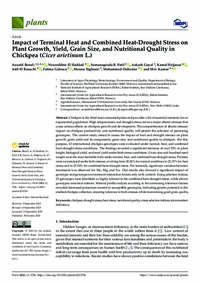Impact of Terminal Heat and Combined Heat-Drought Stress on Plant Growth, Yield, Grain Size, and Nutritional Quality in Chickpea (Cicer arietinum L.)

Authors:
Chickpea is the third most consumed pulse and provides a kit of essential nutrients for an exponential population. High temperatures and drought stress are two major abiotic stresses that cause serious effects on chickpea growth and development. The comprehension of abiotic stresses’ impact on chickpea productivity and nutritional quality will permit the selection of promising genotypes. The current study aimed to assess the impact of heat and drought stresses on plant growth, grain yield and its components, grain size, and nutritional quality in chickpea. For this purpose, 43 international chickpea genotypes were evaluated under normal, heat, and combined heat-drought stress conditions. The findings revealed a significant decrease of over 50% in plant height, biological yield, and seed yield under both stress conditions. Grain size and hundred-seed weight were the most heritable traits under normal, heat, and combined heat-drought stress. Proteins were accumulated under both stresses, evolving from 20.26% for normal conditions to 22.19% for heat stress and to 21.94% for combined heat-drought stress. For minerals, significant variation between treatments was observed for Mn, Mg, and Na. Our results also showed a significant impact of genotype and genotype-environment interaction factors only on K content. Using selection indices, 22 genotypes were identified as highly tolerant to the combined heat-drought stress, while eleven genotypes were heat-tolerant. Mineral profile analysis according to the contrasting tolerance clusters revealed decreased potassium content in susceptible genotypes, indicating genetic potential in the studied chickpea collection, ensuring tolerance to both stresses while maintaining good grain quality.
